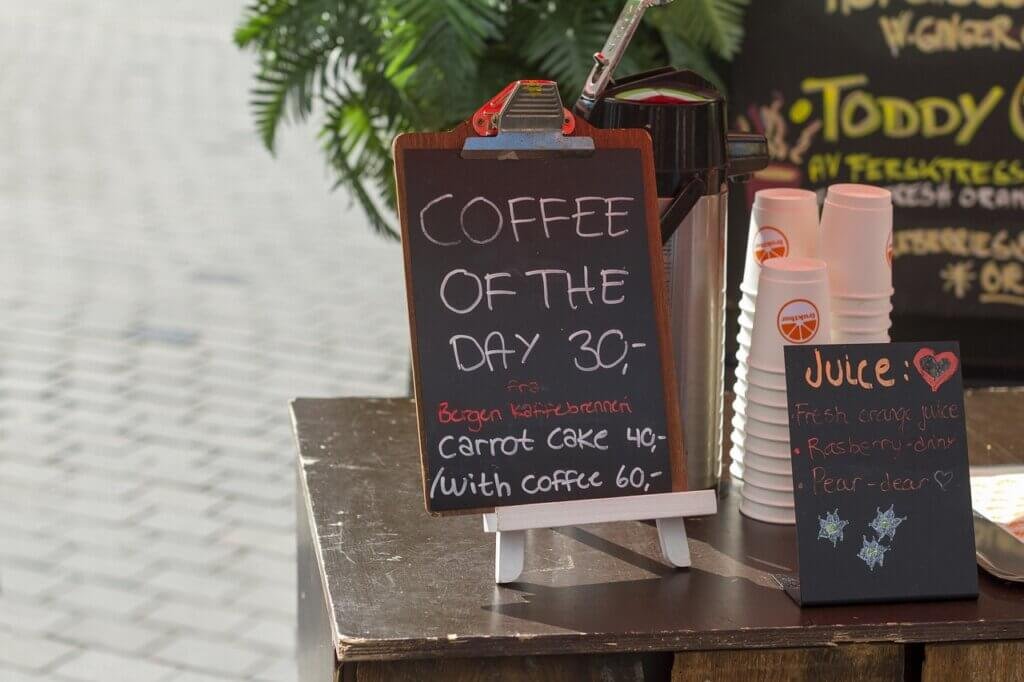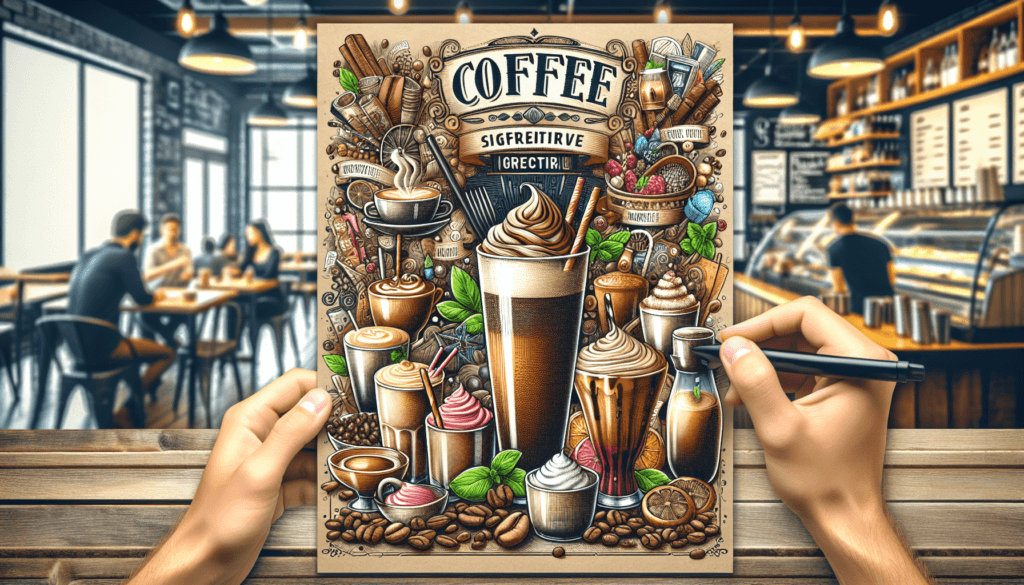Are you looking to make your coffee shop stand out from the competition? Developing a signature coffee menu is the key to attracting customers and keeping them coming back for more. In this article, we will explore the essential steps to creating a unique and captivating coffee menu that embodies the personality and brand of your business. From selecting the perfect coffee beans to crafting delightful flavor combinations, we will guide you through the process of developing a menu that will leave a lasting impression on your customers. Get ready to revolutionize your coffee offerings and bring your business to the next level.

Step 1: Understanding Your Target Audience
Identifying your target market
When developing a signature coffee menu for your business, the first step is to identify your target market. Consider who your ideal customers are and what their preferences and tastes in coffee might be. Are they millennials looking for trendy and artisanal brews, or are they professionals on the go who appreciate convenience? By understanding your target market, you can tailor your coffee offerings to meet their needs and desires.
Conducting market research
Market research is essential to gain insight into your target market’s coffee preferences. Look into local coffee consumption trends, visit competing coffee shops, and analyze customer behavior. You can also conduct surveys or focus groups to gather feedback directly from your potential customers. By conducting thorough market research, you can gather valuable insights that will inform your coffee menu development process.
Analyzing customer preferences
Once you have gathered market research data, it’s time to dive deeper into your target customers’ preferences. Analyze the survey responses, focus group feedback, and any other information you’ve collected to identify common themes or patterns. Pay attention to the types of coffee beverages your potential customers enjoy, their preferred flavor profiles, and their willingness to try new and unique offerings. This analysis will help you craft a coffee menu tailored to your customers’ tastes and preferences.
Step 2: Assessing Your Resources
Evaluating available equipment
Before finalizing your coffee menu, evaluate the equipment you have or plan to invest in. Different coffee beverages require different brewing methods and equipment. Consider the capabilities of your espresso machines, coffee brewers, grinders, and any other tools you will be using to make your coffee offerings. This evaluation will help ensure that your menu choices align with your available equipment and resources.
Determining budget constraints
Developing a coffee menu involves considering your budget constraints. You need to assess the costs associated with procuring quality coffee beans, ingredients for specialty drinks, and any additional supplies needed for your coffee menu. It’s essential to strike a balance between offering high-quality and unique coffee offerings while keeping your budget in check.
Assessing ingredient suppliers
To maintain consistent quality and flavor in your coffee menu, it’s crucial to assess your ingredient suppliers. Research and select suppliers who provide high-quality coffee beans, milk, flavor syrups, and any other ingredients you will be using in your beverages. Building strong relationships with reliable suppliers ensures that you consistently deliver excellent coffee to your customers.

Step 3: Selecting Your Core Coffee Offerings
Choosing the right coffee beans
The quality and type of coffee beans you use are critical to the success of your coffee menu. Consider factors such as origin, roast level, and flavor profiles when selecting your beans. Determine whether your target market prefers single-origin or blended coffees, and choose beans that align with their preferences. Explore different options, such as Arabica or Robusta beans, and consider experimenting with unique flavor profiles to set your coffee offerings apart.
Deciding on roast profiles
The roast profile of your coffee beans greatly impacts the taste and aroma of your brews. Consider the preferences of your target market when choosing the roast level for your coffee menu. Light roasts highlight the unique characteristics of the beans, while medium and dark roasts offer bolder flavors. Experiment with different roast profiles to create a well-rounded coffee menu that caters to a variety of taste preferences.
Exploring various brewing methods
In addition to choosing the right coffee beans and roast profiles, explore different brewing methods to offer a diverse range of coffee options to your customers. Consider offering popular choices such as espresso, pour-over, French press, and cold brew. Each brewing method brings out unique flavors and characteristics in the coffee beans, allowing your customers to experience a variety of tastes and aromas. Make sure to train your baristas in mastering these brewing techniques to consistently deliver excellent coffee to your customers.
Step 4: Creating Signature Coffee Blends
Experimenting with flavor combinations
Creating signature coffee blends involves experimenting with flavor combinations to craft unique and memorable brews. Consider incorporating different flavor elements such as chocolate, caramel, fruit, or nutty undertones into your blends. Experiment with blending different types of coffee beans and varying roast levels to achieve the desired flavor profiles. Don’t be afraid to think outside the box and create innovative flavor combinations that will intrigue and delight your customers.
Crafting unique blend profiles
Once you have identified flavor combinations that work well together, it’s time to craft unique blend profiles for your coffee menu. Determine the ratio of different beans in each blend to achieve the desired taste and strength. Carefully document and refine your recipes to ensure consistency across your offerings. Creating unique blend profiles sets your coffee menu apart from competitors and gives your customers a reason to keep coming back for more.
Balancing acidity, body, and aroma
When creating signature coffee blends, it’s essential to balance acidity, body, and aroma. Acidity refers to the brightness and crispness of the coffee, with some beans having a more citrusy or fruity acidity profile. Body refers to the heaviness or thickness of the coffee, ranging from light and delicate to bold and full-bodied. Aroma encompasses the pleasant scent that wafts from the coffee, contributing to the overall sensory experience. Experiment with different combinations of beans and roasts to achieve a well-rounded balance of these elements in your coffee blends.

Step 5: Developing Specialty Coffee Drinks
Researching popular coffee trends
Developing specialty coffee drinks involves staying up-to-date with popular coffee trends. Research emerging trends in the coffee industry, such as latte art, flavored foam toppings, or unique brewing techniques, and consider incorporating them into your menu. Stay connected with your target market’s preferences and monitor what other successful coffee shops are offering. By staying informed about the latest trends, you can develop specialty coffee drinks that capture the attention and interest of your customers.
Creating unique and innovative recipes
Differentiate your coffee menu by creating unique and innovative specialty coffee drink recipes. Experiment with flavor combinations, toppings, and presentations to offer drinks that are not only delicious but visually appealing as well. Consider incorporating local and seasonal ingredients to add a touch of freshness and novelty to your offerings. By continuously pushing the boundaries and introducing new recipes, you can keep your coffee menu exciting and enticing for your customers.
Incorporating seasonal flavors
To cater to your customers’ ever-changing tastes and preferences, consider incorporating seasonal flavors into your specialty coffee drinks. Offer refreshing beverages such as iced coffee or fruit-infused brews during the summer months, and warm and cozy flavors like pumpkin spice or gingerbread during the fall and winter seasons. Embracing seasonal flavors creates a sense of novelty and encourages customers to return to your coffee shop throughout the year.
Step 6: Considering Dietary Restrictions
Providing options for dairy-free customers
In today’s diverse market, it’s crucial to cater to customers with dietary restrictions. Provide options for dairy-free customers by offering alternative milk options such as almond, soy, or oat milk. Train your baristas to handle milk substitutions and ensure they can create delicious and satisfying dairy-free coffee beverages. Including these options in your coffee menu shows your commitment to inclusivity and allows you to serve a broader customer base.
Developing alternatives for gluten-free individuals
Another important consideration is catering to individuals with gluten-free dietary needs. Ensure that your coffee shop offers gluten-free pastries or snacks that customers can enjoy alongside their coffee. Additionally, make sure your baristas are aware of potential cross-contamination risks and can address inquiries or concerns from gluten-sensitive customers. By accommodating gluten-free individuals, you create a welcoming environment and demonstrate your commitment to meeting diverse customer needs.
Addressing sugar-free preferences
For customers who prefer to reduce their sugar intake, it’s essential to provide options that meet their preferences. Consider offering sugar-free syrups or sweeteners that can be added to beverages upon request. Train your baristas to recommend and prepare low-sugar or sugar-free alternatives for customers looking for healthier options. By addressing sugar-free preferences, you can ensure that all customers feel valued and welcomed in your coffee shop.

Step 7: Pricing Your Coffee Menu
Calculating ingredient costs
To determine the appropriate pricing for your coffee menu, it’s important to calculate the ingredient costs associated with each beverage. Factor in the costs of coffee beans, milk, flavor syrups, and any additional ingredients used in the preparation of each drink. Consider the portion sizes and serving amounts to accurately determine the ingredient costs per cup. By understanding your ingredient costs, you can set pricing that ensures profitability while remaining competitive in the market.
Factoring in overhead expenses
In addition to ingredient costs, it’s essential to consider overhead expenses when pricing your coffee menu. Take into account rent, utilities, staff wages, marketing expenses, and any other costs associated with running your coffee shop. Calculate the average daily or monthly overhead expenses and distribute them across your menu items to ensure that your pricing covers all operational costs.
Competitive pricing analysis
To remain competitive, it’s crucial to conduct a pricing analysis of your competitors’ coffee menus. Research local coffee shops similar in size and concept to yours and compare their prices for similar beverages. Consider the perceived value of your offerings and how they compare to your competitors. Striking the right balance between profitability and a competitive price point will ensure that your coffee menu attracts customers while meeting your financial goals.
Step 8: Designing an Inviting Menu Layout
Choosing a visually appealing concept
A visually appealing menu layout is crucial for enticing customers and showcasing your coffee offerings. Choose a concept or theme that aligns with your brand and target market. Whether it’s minimalist, rustic, or modern, ensure that the design reflects the atmosphere and experience you want to provide in your coffee shop. Utilize eye-catching colors, fonts, and images that evoke a sense of warmth, comfort, and quality.
Organizing items in logical categories
Organize your coffee menu items in logical categories to help customers navigate through the options effortlessly. Group similar beverages together, such as espresso-based drinks, drip coffee, and specialty drinks. Consider labeling the categories clearly and using headings or separators to provide visual structure and aid readability. A well-organized menu layout enhances customer experience and ensures they can easily find their desired coffee choice.
Using eye-catching descriptions
Capture the attention of your customers by using eye-catching descriptions for each coffee beverage on your menu. Highlight the unique flavors, aromas, or brewing techniques that make each drink special. Utilize vivid and enticing language to evoke sensory experiences and create anticipation. Engaging descriptions not only make your coffee menu more interesting but also help customers make informed choices based on their preferences.

Step 9: Training Your Baristas
Educating staff on coffee origins
To provide exceptional customer service and deliver high-quality coffee, it’s essential to educate your baristas on coffee origins. Teach them about the origins, characteristics, and flavor profiles of different coffee beans. By understanding the journey from bean to cup, your baristas can share this knowledge with customers, enhancing their coffee experience and building trust in your expertise.
Teaching brewing techniques
Baristas should be well-versed in various brewing techniques to consistently produce excellent coffee. Provide comprehensive training on espresso extraction, drip brewing, pour-over methods, and any other techniques relevant to your coffee menu. Encourage your baristas to continue learning and refining their skills to ensure that customers receive well-brewed and flavorful coffees with every order.
Fostering exceptional customer service
Exceptional customer service is a vital component of a successful coffee shop. Train your baristas on the importance of warm, friendly, and attentive customer interactions. Teach them to listen to customers’ preferences, explain menu options, and offer recommendations based on taste profiles. Focus on creating a welcoming and inclusive atmosphere where customers feel valued and appreciated. Exceptional customer service not only keeps customers coming back but also attracts new ones through positive word-of-mouth.
Step 10: Seeking Customer Feedback
Encouraging reviews and suggestions
Actively encourage customers to provide reviews and suggestions regarding your coffee menu. Display signage or place cards on each table inviting customers to provide feedback. Encourage them to leave reviews on online platforms or provide feedback forms at the counter. Creating a culture of feedback shows that you value your customers’ opinions and are committed to continuously improving their coffee experience.
Conducting surveys or tastings
Consider conducting surveys or tastings to gather more specific feedback from your customers. Create questionnaires that address various aspects of your coffee menu, such as taste, presentation, and overall satisfaction. Additionally, consider hosting tasting events where customers can sample new offerings and provide real-time feedback. Surveys and tastings are valuable tools for gathering in-depth insights and ideas for menu enhancements.
Implementing changes based on feedback
Lastly, don’t let customer feedback go to waste; use it to drive positive changes in your coffee menu. Implement changes or enhancements based on the feedback you receive, whether it’s adding new drinks, improving recipes, or addressing specific customer requests. Continuously evolving your coffee menu based on customer feedback not only demonstrates your commitment to their satisfaction but also keeps your offerings fresh, exciting, and relevant to their evolving preferences.
By following these ten steps, you can develop a signature coffee menu for your business that captivates your target audience, elevates your brand, and keeps customers coming back for more. Remember, developing a successful coffee menu is an ongoing process that requires attention to detail, creativity, and a deep understanding of your customers’ needs and preferences.


